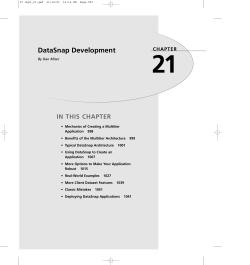
Track 1: The Empowered Business
Track 1: The Empowered Business
“Using Progress OpenEdge, Corticon, Rollbase
and Node.js to create a dynamic, rule- and
model-driven Web-UI”
» Mike Liewehr, AKIOMA Software
» Frank Hilhorst, Progressive Consulting
Agenda
The Idea
The Solution
Technical overview
Architecture explained on a live sample
Detailed technical explanation
Q&A
2
The Idea
“Building web based configuration forms for
self service sales of complex products
without coding”
3
The Idea
Build complex, web based configuration forms without coding
Examples:
…Car configurator
…Complex custom-built machines
…Online Insurance Enrollment
Technically these are all similar
4
The Concept
…code rules
…code and design UI
…build database structure
Dramatically reduced time-to-market
Lower costs
No errors
Requirements and challenges
Challenges that came up when building the solution…
Data definitions vary greatly (cars, machines, people, policies…)
• Need a way to define data definition by end-user
Complex rules, that are fully customer driven
• Allow to define complex rules without coding
Rich Browser-based UI
• UI has to be very flexible and dynamic, support for rich
components
Performance!
• UI has to adapt in realtime
9
challenges
Challenges that came up when building the solution…
…and the Products to solve them:
Data definitions vary greatly (cars, machines, people, insurance…)
• Progress Rollbase
Complex rules, that are fully customer driven
• Progress Corticon
Rich UI which has to be very flexible and dynamic
• AKIOMA HTML5-Client
Performance! -> UI has to adapt in realtime
• Node.JS / Socket.IO / node4Progress / ABL (and some magic… )
10
Solution Live Demo
11
Technical details
Corticon Rulesengine
Node.js
• Socket.IO
• Node4Progress
•
•
Server
Rulesheet
Vocabulary
OpenEdge Appserver
•
•
screenDS
AKIOMA
UIConnector
Client
Webbrowser
•
•
•
•
HTML5
JavaScript
SWAT UI
Socket.IO
12
Technical details
Server
Corticon Rules Engine
-
Rule Sheet
Vocabular
OE Appserver
-
ScreenDS
AKIOMA
UI Connector
8
Node.js
-
Socket.IO
Node4Progress
A 1
B 42
C 3
D
-
HTML 5
JavaScript
SWAT UI
Socket.IO
Client
13
Detailed technical explanation
Detailed explanation of the Architecture
14
Introduction to Node & Node4Progress
About Node
Server side javascript engine
Lightweight, scalable and fast
Implements non-blocking programming model
Involves using callback procedures
Allows you to build web applications with features
that cannot be accomplsihed any other way
Hot technology
Microsoft is going Node, Progress is going Node,
everybody is going Node
About node4progress
Bridge for accessing business logic on appserver
directly from Node
15
Node4Progress Mission
Provide flexible and fast way to access business
functionality of the appserver
Without additional effort to support new appserver
procedures
Minimizing the number of middleware components
needed (e.g. Tomcat)
16
Node4Progress Features and characteristics
Small foot print (4MB)
Fast
Easy to install
Npm install node4progress
Communicates with appserver through Java
OpenClient
Supports 2 methods for calling an appserver
procedure
Calling a handler
Dynamic appserver call
Employs dataset object modelled after Progress
ProDataset
17
Converting output parameters of an Appserver
procedure into a JSON structure
{"output":{
"OutputParametes-1" : ".....",
"OutputParametes-2" : ".....",
"dsCustomer" : {...},
“ErrMsg" : ""
},
"error": "“
}
Root level output tag contains output parameters
parameters from appserver procedure
Root level error tag contains error message if
execution of appserver procedure failed
18
Calling a handler
var node4progress = require("node4progress")(null);
var handler = "handlers/CustomerHandler.p";
var inputPars = "NumCustomersToPull=2";
node4progress.callHandler(handler, inputPars,
function(err,result){
console.log(result);
});
19
Approach to calling any appserver procedure
dynamically
Define appserver procedure to call
Node4progress.setAppSvrProc(....);
Define each parameter
Node4progress.setParameter(......);
Define callback procedure
Invoke appserver procedure
Node4progress.invoke(callback);
20
Calling appserver procedure dynamically
(example)
var node4progress = require("node4progress")(null);
node4progress.setAppsvrProc("handlers/CustomerHandler.p","",false,true);
node4progress.setParameter(
"InputPars",
"longchar",
"input",
"NumCustomersToPull=5&batchNum=2","");
node4progress.setParameter("OutputPars","character","output","","");
node4progress.setParameter("dsCustomer","dataset-handle","output","","");
node4progress.setParameter("ErrMsg","character","output","","");
node4progress.invoke(function(err,result){
if(err){
console.log("ERROR->"+err);
}else{
console.log(result);
result=JSON.parse(result);
}
});
21
Parameter types supported
Data-types
Character
Integer
Int64
Decimal
Longchar
Date/Date-time
Table-handle
Dataset-handle
Modes
Input
Input-output
Output (append)
22
Challenges of working with data
When passing data as input
Data needs to be formatted exactly right
i.e. In read-json format
Working directly with raw JSON structure is error prone
Solution
The node4progress dataset and temp-table objects
23
The node4progress dataset object
Getting the data in a dataset object
dataset = node4progress.getDataSet(
“dsCustomer”,
AppSvrOutputJson);
Objects provided
Dataset
TempTable
Buffer
BufferField
copyDataset, emptyDataset, writeJson
forEach, bufferCreate, bufferCopy, bufferDelete, copyTempTable,
emptyTempTable, findFirst, findLast, writeJson
Method provided at the dataset level
Methods provided at the TempTable level
Methods provided at the buffer level
Display, writeJson
24
The node4progress dataset object
Getting the data in a dataset object
dataset = node4progress.getDataSet(
“dsCustomer”,
AppSvrOutputJson);
Navigating the data in a temp-table
dataset.$(“ttCustomer”).forEach(function(ttCustBuf){
custNum=ttCustBuf.$(“cust-num”).$(“bufferValue”);
name=ttCustBuf.$(“name”).$(“bufferValue”);
});
Creating a new record in a temp-table
ttCustBuf = dataset.$(“ttCustomer”).bufferCreate().
Populating the fields in a newly created temp-table record
ttCustBuf.$(“Cust-num”).bufferValue(100);
ttCustBuf.$(“name”).bufferValue(“frank Hilhorst”);
25
The node4progress dataset object
(continued)
Buffer-copy data into a temp-table buffer
data = {“cust-num”: 1180, “name”:”Frank Hilhorst”,”City”:”Miami”};
ttBuf = dataset.$(“ttCustomer”).findFirst();
ttBuf.bufferCopy(data);
Sending updated dataset as input
var jsonStr = dataset.writeJson();
node4progress.setAppsvrProc("AppProc.p”."",false,true);
node4progress.setParameter(
"dsCustomer",
"dataset-handle",
"input-output",
“dsOrderSchema.p”,
jsonStr);
26
Summary
Progress offers great products
Combined they provide even more value
The whole is more than the sum of its parts
Node.JS is here to stay and provides great
value for Progress partners
27
Questions?
Questions?
28
Visit the Resource Portal
Get session details & presentation
downloads
Complete a survey
Access the latest Progress product
literature
www.progress.com/exchange2014
© Copyright 2025



















